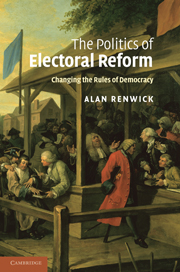Book contents
- Frontmatter
- Contents
- List of tables
- List of figures
- List of abbreviations
- Acknowledgements
- 1 Introduction
- PART I Building blocks
- PART II Elite majority imposition
- PART III Elite–mass interaction
- 9 Italy: diluting proportional representation
- 10 Japan: the abandonment of SNTV
- 11 New Zealand: MMP in a Westminster setting
- 12 Elite–mass interaction: comparative analysis
- 13 Conclusions and implications
- Appendix: glossary of electoral system terminology
- Bibliography
- Index
13 - Conclusions and implications
Published online by Cambridge University Press: 04 May 2010
- Frontmatter
- Contents
- List of tables
- List of figures
- List of abbreviations
- Acknowledgements
- 1 Introduction
- PART I Building blocks
- PART II Elite majority imposition
- PART III Elite–mass interaction
- 9 Italy: diluting proportional representation
- 10 Japan: the abandonment of SNTV
- 11 New Zealand: MMP in a Westminster setting
- 12 Elite–mass interaction: comparative analysis
- 13 Conclusions and implications
- Appendix: glossary of electoral system terminology
- Bibliography
- Index
Summary
The chapters of Part I contained detailed analysis of particular aspects – building blocks – of electoral reform. The chapters of Parts II and III analysed major instances of electoral reform in established democracies since the Second World War. In this chapter, I return to the big picture. I begin by outlining the conclusions that emerge from the previous chapters regarding the nature of electoral reform processes. I then consider the implications of those conclusions for the major questions that I asked in the first chapter, concerning who has power over electoral system outcomes, whose interests or which values those outcomes serve, and what patterns outcomes are likely to exhibit. Finally, I hazard a look at the future: should we expect the patterns observable in recent decades to remain the same in the years ahead, or might the politics of electoral reform take on new shape?
The nature of electoral reform in established democracies
Processes of electoral reform, I have argued, can take many forms. In established democracies, two types predominate: reform by elite majority imposition and by elite–mass interaction.
The factor that most obviously differentiates these types from each other and from non-reform is the attitude of the public. Where the public actively pushes for change in the electoral system, then reform by elite–mass interaction becomes possible. The evidence analysed in preceding chapters suggests, I have argued, that this can occur where a major crisis generates public anger at the state of the political system as a whole, where a plausible case can be made that electoral reform could alleviate the causes of that anger – where there are inherent problems in the electoral system itself – and where pro-reform leaders actively make that link between the crisis and the electoral system.
- Type
- Chapter
- Information
- The Politics of Electoral ReformChanging the Rules of Democracy, pp. 239 - 255Publisher: Cambridge University PressPrint publication year: 2010



